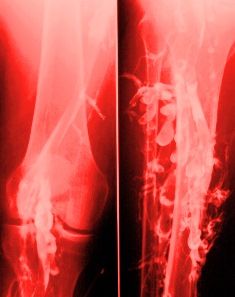
Venous thrombosis prevention
Definition
Venous thrombosis prevention is really a way to prevent thrombus from building in veins inside the body.
Purpose
Different preventative methods may also keep normal blood circulation and for that reason allow oxygen and nutrients to achieve cells from the body. Thrombus could be painful and may cause serious harm to tissues and organs. Sometimes, they are able to cause rapid death. Blood clot avoidance can enhance blood circulation and may save lives.
Preparation
The most crucial preparation how the patient can perform is discuss his / her personal risk of developing thrombus having a physician. If medicine is given, the individual ought to be instructed how to get it and what unwanted effects to consider. Special exercises ought to be told the individual, along with a daily walk ought to be encouraged.
Description
Thrombus can build in a vein inside the body. Deep vein thrombosis (DVT) can be very serious. DVT occurs whenever a blood clot forms within the legs or pelvis. If it's big enough, it may block the blood circulation inside the vein, cutting off oxygen towards the tissues. An embolus or perhaps a clot that breaks from the wall from the circulation system can travel to the lung, one's heart, or even the brain where it may disrupt the standard functioning of those organs and be life-threatening. Some thrombus distends the walls from the circulation system, developing a sac called an aneurysm. Sometimes the aneurysm bursts, creating blood to leak out. If occurs inside the brain, one's heart, or even the lungs, it may be fatal. Venous thrombosis may appear for many reasons. The individual might have disease inside the arteries for example an inflammatory reaction from the walls from the vein (phlebitis) or hereditary blood clotting disorders. The individual could also develop thrombus due to other health conditions for example cardiovascular disease, heart failure, stroke or cancer. They are also able to occur after surgical procedures or prolonged bed rest or inactivity. Smoker's take oral contraceptives might be weaker to thrombus. Pulmonary embolism is among the most typical, but highly fatal, thrombus that patient experience.
Prevention methods
There are many methods doctors use to avoid thrombus. Some use medicines, others make use of mechanical means, but still others need behavioral changes, or perhaps a mixture of many of these.
Mechanical leg pumps (pneumatic compression stockings)
Mechanical stimulation from the leg muscles from the leg might help stimulate blood circulation. Many hospitals need all surgery patients, particularly those who've abdominal or cardiac surgery, to put on pneumatic compression stockings. The unit covers the low leg from ankle towards the knee, some reach up to the thigh. When connected and switched on, a pneumatic device pumps air into chambers inside the stocking, which delicately tighten round the legs for some seconds after which are freed. This pulsing massage retains the blood flowing and discourages venous thrombosis.
Exercise
Sitting for long stretches or just being limited to bed after surgical procedures or throughout a long illness can slow blood circulation, allowing clots to create. As quickly as possible after surgery, the individual should move the legs, stand, and start taking short walks. Travelers or individuals who work sitting in a desk or computer for many hours and hours should take break every hour to obtain up and maneuver around. While relaxing in the confines of the airplane or lying during sex, specific exercises, for example ankle circles or leg lifts, can be achieved also.
Compression stockings
Often doctors advocate compression stockings for patients to avoid DVT and edema, and also to treat spider veins and phlebitis. Graduated compression stockings employ more pressure in the ankle and fewer in the leg and nearer to the knee. This pressure inhibits backflow of blood and clot formation.
Heparin along with other blood thinners
Anticoagulants are blood thinners, for example heparin in many cases are prescribed as prophylactics for venous thrombosis. These drugs reduce the clotting ability from the blood. There's been excellent success merging heparin and pneumatic compressions stockings, specifically for colorectal and cardiac surgery patients. There are several precautions, however, for implementing this drug. Those who have had a silly a reaction to the drug shouldn't go, in addition to individuals with allergies to beef and pork. Girls that are pregnant and nursing should just use with caution. Additionally, certain medicines shouldn't be combined with heparin. They include aspirin, hyperthyroid medicine and drugs for pain or inflammation.
Fluids
It is necessary to not restrict fluids when coping with surgery, traveling, or employed by long stretches inside a seated position. Not simply will patient’s body remain hydrated but drinking fluids can help prevent venous thrombosis. Drinking fluids retains the blood liquid and moving, discouraging clot formation. Travelers should drink a little something every hour. This can be difficult since some airline carriers might not have frequent beverage service.
Normal results
These prevention methods might help patient to avoid using a blood clot after surgical procedures or during long stretches of inactivity, for example bed rest or on a trip. Travelers and sedentary workers could find getting around and drinking fluids work best means of these phones prevent thrombus. For patients coping with surgery, however, a mix of methods is generally necessary. Pneumatic compression pumps with or with no round of heparin could be the smartest choice for surgery patients.





